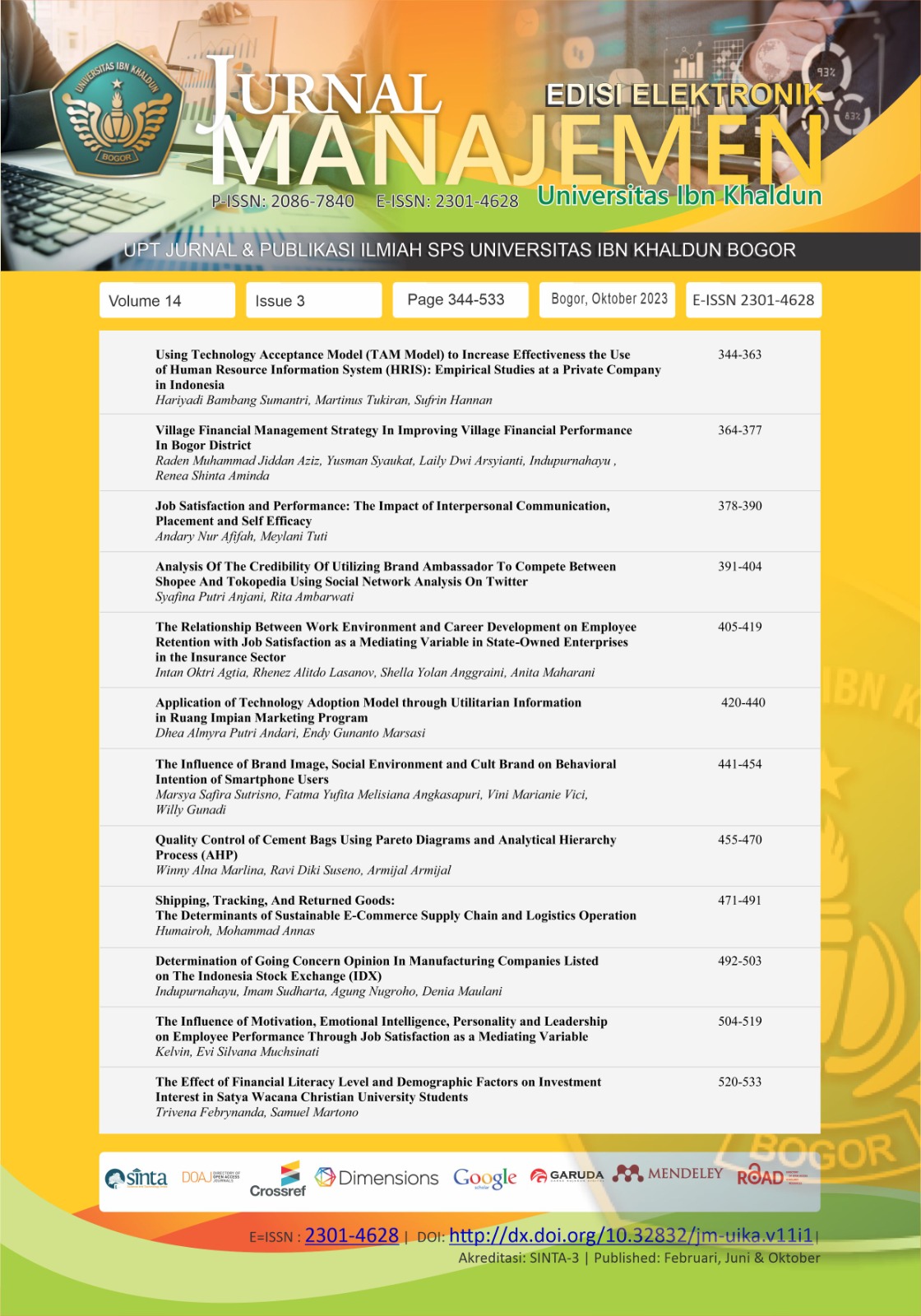Using Technology Acceptance Model (TAM Model) to Increase Effectiveness the Use of Human Resource Information System (HRIS)
Empirical Studies at a Private Company in Indonesia
DOI:
https://doi.org/10.32832/jm-uika.v14i3.14492Keywords:
Perceived Ease of Use, Perceived Usefulness, Behavioral Intention to Use, Actual System UseAbstract
Studies related to HRIS Applications show that the Technology Acceptance Model can be used to increase the use of HRIS Applications in a company. This research aims to test and reveal empirical factors that influence using the HRIS-Pakoku Application in the Pako Group. The two direct factors are perceived ease of use and perceived usefulness, and the indirect factor is a behavioural intention to use. This research was conducted at Pako Group using a questionnaire survey method, and samples were taken using the proposed stratified random sampling technique of 138 employees using HRIS at Pako Group. SEM analysis is used to determine the influence between research variables. The research results show a positive and significant influence of perceived ease of use on actual system use, a positive and significant influence of perceived usefulness on actual system use, and a positive and significant influence of behavioural intention to use on actual system use. There is a positive and insignificant influence of perceived ease of use on actual use through intention to use behaviour, and there is a positive and insignificant influence of perceived usefulness on actual system use through intention to use behaviour.
References
Calvo-Porral, C., & Pesqueira-Sanchez, R. (2020). Generational differences in technology behaviour: comparing millennials and Generation X. Kybernetes, 49(11), 2755–2772. doi: 10.1108/K-09-2019-0598
. Fornell, C., & Larcker, D. F. (1981). Structural Equation Models with Unobservable Variables and Measurement Error: Algebra and Statistics. Journal of Marketing Research, 18(3), 382–388. doi: 10.1177/002224378101800313
. Gefen, D., & Straub, D. W. (1997). Gender differences in the perception and use of e-mail: An extension to the technology acceptance model. MIS Quarterly, 389–400.
. Ghozali, I., & Latan, H. (2012). Partial least square: Konsep, teknik dan aplikasi SmartPLS 2.0 M3. Semarang: Badan Penerbit Universitas Diponegoro.
. Hair, J. F., Ringle, C. M., & Sarstedt, M. (2013, March 14). Editorial - Partial Least Squares Structural Equation Modeling: Rigorous Applications, Better Results and Higher Acceptance. Retrieved from https://papers.ssrn.com/abstract=2233795
. Lai, K.-W., & Hong, K.-S. (2015). Technology use and learning characteristics of students in higher education: Do generational differences exist? British Journal of Educational Technology, 46(4), 725–738. doi: 10.1111/bjet.12161
. Muliati, N. (2019). Pengaruh Perceived Usefulness, Perceived Ease Of Use, Attitude Toward Using Dan Behavior Intention To Use Terhadap Actual System Use Dalam Implementasi Teknologi Enterprise Resource Planning (ERP) System (Studi Pada End User ERP System Di PT Semen Gresik). Jurnal Manajemen Dan Inovasi (MANOVA), 2(2), 31–46. doi: 10.15642/manova.v2i2.191
. Nasir, M. (2013). Evaluasi Penerimaan Teknologi Informasi Mahasiswa di Palembang Menggunakan Model UTAUT. Seminar Nasional Aplikasi Teknologi Informasi (SNATI), 15–2013. Retrieved from https://journal.uii.ac.id/Snati/article/view/3006
. Nursiah, N. (2017). Pengaruh Perceived Ease Of Use Dan Perceived Usefulness Terhadap Behavior Intention To Use. Jurnal Elektronik Sistem Informasi Dan Komputer, 3(2), 39–47. Retrieved from https://jesik.web.id/index.php/jesik/article/view/69
. Rommalla, S. (2017). Repotnya HRD Jika Tak Dibantu Software. Retrieved July 15, 2023, from gadjian.com website: https://www.gadjian.com/blog/2017/12/11/hrd-repot-mengelola-sdm-tanpa-software-infografis/
. Sekaran, U., & Bougie, R. (2016). Research methods for business : A skill-building approach Fourth Business. In John Wiley and Sons. New York: Wiley. Retrieved from https://www.wiley.com/en-ae/Research+Methods+For+Business%3A+A+Skill+Building+Approach%2C+7th+Edition-p-9781119266846
. Solimun, Fernandes, A. A. R., & Nurjannah. (2017). Metode Statistika Multivariat Pemodelan Persamaan Struktural. Malang: Universitas Brawijaya Press.
. Stern, P. J. (2002). Generational differences. The Journal of Hand Surgery, 27(2), 187–194. doi: 10.1053/jhsu.2002.32329
. Tukiran, M., Sunaryo, W., Wulandari, D., & Herfina. (2022). Optimizing Education Processes During the COVID-19 Pandemic Using the Technology Acceptance Model. Frontiers in Education, 7. doi: 10.3389/feduc.2022.903572
. Umar, H. (2005). Manajemen riset dan Perilaku Konsumen. Jakarta: PT. Gramedia.
. Wida, P. A. M. W., Yasa, N. N. K., & Sukaatmadja, I. P. G. (2016). Aplikasi model tam (technology acceptance model) pada perilaku pengguna instagram. Jurnal Ilmu Manajemen Mahasaraswati, 6(2), 101948.
Downloads
Published
How to Cite
Issue
Section
License
Copyright (c) 2023 Jurnal Manajemen (Edisi Elektronik)

This work is licensed under a Creative Commons Attribution-NonCommercial 4.0 International License.
Authors who publish with this journal agree to the following terms:
- Authors retain copyright and grant the journal right of first publication with the work simultaneously licensed under a Creative Commons Attribution-NonCommercial-ShareAlike 4.0 International License that allows others to share the work with an acknowledgement of the work's authorship and initial publication in this journal.
- Authors can enter into separate, additional contractual arrangements for the non-exclusive distribution of the journal's published version of the work (e.g., post it to an institutional repository or publish it in a book), with an acknowledgement of its initial publication in this journal.
- Authors are permitted and encouraged to post their work online (e.g., in institutional repositories or on their website) prior to and during the submission process, as it can lead to productive exchanges, as well as earlier and greater citation of published work (See The Effect of Open Access).











